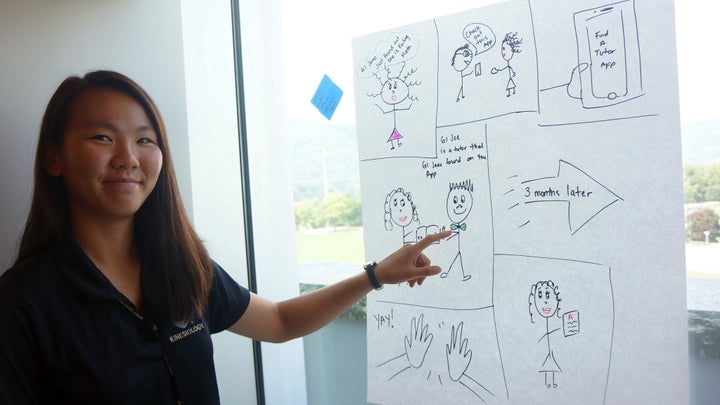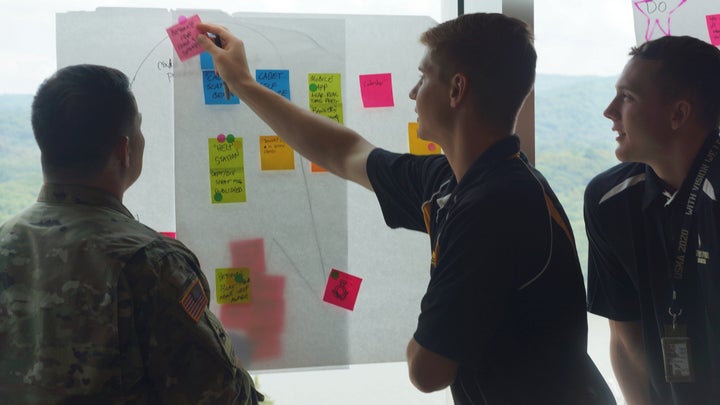
A West Point cadet presents her team’s design concept at a workshop taught by the authors, August 2017
In recent years, businesses and governments have been increasingly recognizing the value of design. We see more intuitive products, navigable services, and coherent experiences. But design—as a discipline, and as a mindset—has even more to offer. An investment in broadening access to design education is more than good economic policy, it can be a way to build stronger communities and a more robust democracy.
Design education can enhance democratic engagement because design is more than a discipline that produces slick digital interfaces or beautiful products. Design, looked at broadly across specialties and sub-disciplines, is essentially a problem-solving process that is empathetic, practical, and participatory.
Good design work is empathetic, as it requires practitioners to understand the needs (both articulated and unspoken), motivations, and challenges of users of a product, service, or system. It is practical, as design is a discipline biased toward prototyping, experimentation, and learning by making. It is participatory, as it requires partnerships between designers, users, and other stakeholders.
The business world already understands the value of design in terms of return on investment. A 2015 study conducted by the Design Management Institute and Motiv Strategies and funded by Microsoft found that design-driven companies out-perform the S&P average by 211%. The researchers found that, over the last decade, design-driven companies have had a significant share price advantage over their less design-conscious competitors.
Increasingly, government also understands the value of design. The Obama era saw new attention paid to the value of design at all levels of government. The U.S. Digital Service and the City of New York have developed their own digital playbooks that help define standards for designing better-performing and more equitable public services in the networked age.
In the era of social media and mass participation, teaching design to our young people and fellow citizens is the key to building a more robust democracy. Just as design is not merely a matter of aesthetics, democracy means more than showing up to vote every couple of years. Real self-government requires multiple forms of engagement, and, to engage well, we must practice civic conversation, negotiation with neighbors, and meaningful collaboration. Fundamentally, both design and democracy are concerned with human agency and accountability: the ability to have a say and to shape our communities, and to be responsible for the choices that we make.
Alexis de Tocqueville, the French observer of early American democracy, observed that associational life strengthened the broader democracy. Today, we can see echoes of that in community maker spaces, design studios, and classrooms across the country. Design students and practitioners are learning to collaborate with each other and with their wider communities to reframe and solve problems. This helps develop skills, social capital, and strengthens local economies.
We need to rethink design education as a basic literacy for people in a democratic society. We learn to read and write so that we can better communicate and collaborate with our fellow citizens. We learn math to better understand and manipulate the abstractions that power the technologies around us. So then, we should learn design in its many forms and facets, to help us understand the many ways that our realities are shaped, from the products and services that we use, to our economic and political systems.
We teach a class on design futures, in which our students design services and products that may not yet be technologically possible. We borrow techniques from science fiction to tell stories and create future worlds that do not exist yet. If we cannot dream it, we cannot build it together. Democracies also depend on big aspirational goals for the future, whether it was Roosevelt’s Four Freedoms, Kennedy’s goal to reach the moon, or Johnson’s Great Society.
Of course, design is just a tool, and, just as it can be used by democratic societies to uplift and empower its people, it can be equally leveraged by dictatorships to oppress and control. If anything, traditionally it has been the despots who better appreciate the role of design to shape behavior and create spectacle. One only need refer to the impressive and imposing architectural legacies of fascist and communist regimes. And indeed, weapons of mass destruction and other tools of violence are also products of design. Good design education is no guarantee of a democratic society, but democratic societies can be better when their people understand design.
To design is to have power, and with power comes responsibility. Design should be something we do as people in a democratic society, not just something that we buy. A people who are educated in design, of any kind, can better cultivate an appreciation for craft, and craftspeople, the people responsible for shaping the products and services that we use as consumers and as citizens.
Design education should not just be about technical skills and craft, but also address issues of ethics and sustainability and connect to a broader civic and environmental consciousness. Who is making the things that we design? How are they treated? Where do the materials and natural resources come from? Are they sustainable?
We teach design thinking to students as well as to seasoned business executives. We begin with empathy, a deep understanding of human needs. Only with a deep understanding of these needs are we able to use design to frame and solve problems in a human-centered way. The design process also requires a mindset of play and experimentation. It requires temporarily withholding judgement at times, teamwork, and a can-do attitude. With the complexity of the problems we face as a society and the complexity of the solutions, be they products or services, design is rarely if ever a solo sport; it’s almost always a team effort.
Empathy, play, experimentation, and collaboration are also capabilities we need for a robust democratic society. An investment in design education is also an investment in democracy.

West Point cadets and faculty organize design insights at a workshop facilitated by the authors, August 2017
This column was written by Lee-Sean Huang and David Colby Reed. They are co-founders of Foossa, a service design and storytelling consultancy based in New York City and teach classes on design, citizenship, and the future at the Parsons School of Design. Lee-Sean is also a participant of the Allies Reaching for Community Health Equity (ARCHE) Public Voices Fellowship with The OpEd Project.
